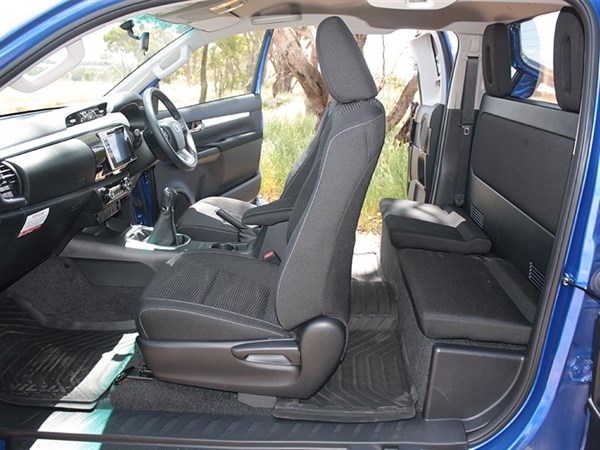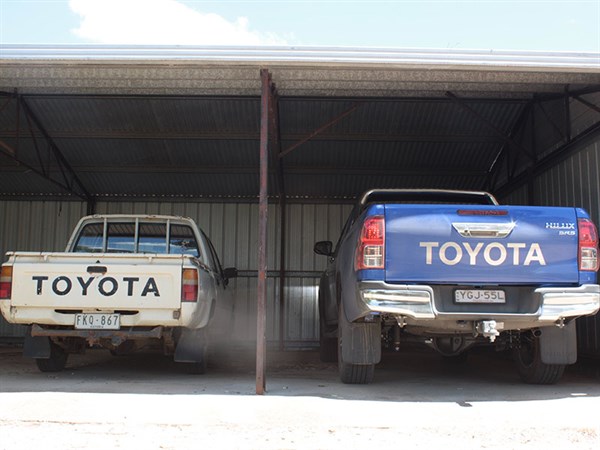Fitting between single-cab and dual-cab models, the HiLux SR5 Extra-Cab has a lot going for it as a work truck and weekend toy hauler
Coordination; some are blessed with it, some are not. I somehow missed out on the hand-eye coordination gene, which means that there are some things that I should not attempt to do, like dance or play any kind of sport that involves a ball, bat or racquet.
People may get hurt and beer may get spilled.
There are many things that appeal to me about an extra-cab ute. As a commercial vehicle they’re much more useful than a dual-cab, they can carry more payload, have more load area (300mm longer than a dual-cab in the case of the HiLux) and you’ve still got a back seat of sorts to squash people you don’t like into.
If you need to carry on a regular basis an extra-cab lets you put some weight in front of the rear axle rather than hanging over the rear wheels as is the case with most dual-cabs.
And in the case of the Toyota HiLux I reckon it’s a much better looking beast in extra-cab form than in dual-cab form. The proportions are just better.
Plus if you like lugging a dirt bike or two around, there’s plenty of tray space as opposed to a dual-cab which will see you squeezing your bike in on an angle and unable to shut the tail gate.
But, as I found out recently, you do need to have some hand-eye coordination to deal with the compact and rather novel four door configuration of the cab.
My HiLux was a 6-speed manual SR5 4×4 Extra-Cab. This means it’s equipped with the 130kW/420Nm (the auto gets 450Nm) common rail 2.8-litre turbo oiler.
Which in my experience to date is a very civilized little donk. It’s best feature from the driver’s seat is it’s low torque curve that comes into play at just 1,400rpm which makes it a pretty relaxed drive even when loaded.
It’s a low compression engine designed to run cleaner with better thermal efficiency. It’s also pretty quiet, especially when compared to the old 3-litre it replaced.
Inside the cab
The idea of having space behind the front seats for storage and occasional seating is not a new one, but these utes are fast become a much more cushy proposition.
The SR5 even has climate control and a touch screen multi-media unit these days. It’s almost comforting that it still comes with rubber floor mats over the carpet!
The jumps seats in the rear though are really just a short trip proposition. You wouldn’t put anyone you liked in there for a long period of time.
But where Mr Unco. (me) struggled with the extra-cab was getting my head around the door configuration.
The small rearward opening suicide doors for example can only be opened once the front door is open. If you happen to be a tight spot like a car park this leaves you with a parked car at your back and an open door either side of you. And nowhere to go without shutting a door
Which is fine unless you want to put someone or something large in the back seat area. If it’s a person you want to load up they have to shut the front door, squeeze past and open it again to climb in the open rear.
Which can be a little intimate if there’s a couple of you.
Same goes for a large bag or a suitcase. You kind of have to position yourself with the bag in front of you, open the front door first shuffle to the left then open the rear, shuffle to the right and then put the bag/suitcase/mound of groceries/person you don’t like/child, inside.
If you have multiple items, you then have to close the doors, fetch the items and repeat the front door/rear door procedure. You can’t shut the back door with the front door closed.
This proved to be a challenge for someone as unco as me and I often found myself standing in between the two open doors breathing through my mouth and vaguely wiggling them until I worked it out.
However, if you are remotely coordinated I’m sure you’ll work it out.
In some ways the extra-cab is the much safer evolution of the old bench seat-equipped single-cab utes of days gone by. An old column shift bench seat-equipped Falcon or Kingswood ute officially had room for 3.
Though there was a time when someone in the bush may have been tempted to illegally squeeze a couple more people in when the wallopers weren’t looking. Not only is this dangerous, it also meant that you may have someone you don’t like half-sitting on your lap while you’re trying to drive.
These days you can stuff that person you don’t like in the back seats of an extra-cab and still be legal. And if they complain too much you can just turn up the stereo.
Performance
The tall gearing of the Toyota means that the tacho is sitting on 1,500rpm at the legal limit, smack at the bottom of the long flat torque curve which runs all the way to 2,600rpm.
The 6-speed is essentially a double overdrive ‘box. Which is good for fuel economy. I averaged 9.8l/100km over a week on rural blacktop and country dirt.
The ute also had just 400km on the clock when I picked it up.
Flexibility is the biggest asset of the extra-cab configuration. And it suits the work-focused nature of the HiLux.
The rest of the ute crop are getting cushier and are now brimming with bells and whistles. The HiLux however hasn’t forgotten it’s vocational roots.
It’s a good thing off road with a smart 4×4 system and it steers well on dirt and lumpy blacktop.
It still, however, rides like an empty truck when……empty. Which again shows the lack of compromise on Toyota’s part in regards to the ‘Lux’s long work pedigree.
As a work truck and weekend toy hauler the extra-cab has a lot going for it. It features plenty of lock up storage space and a big tray, plus a couple of handy jump seats for passengers.
I was even able to fit in the back reasonably comfortably. Plus it’s cheaper than a dual-cab.
But for anyone who has passengers they like, it doesn’t rate as highly, though with a bit of coordination and stereo volume, you may just get by.







